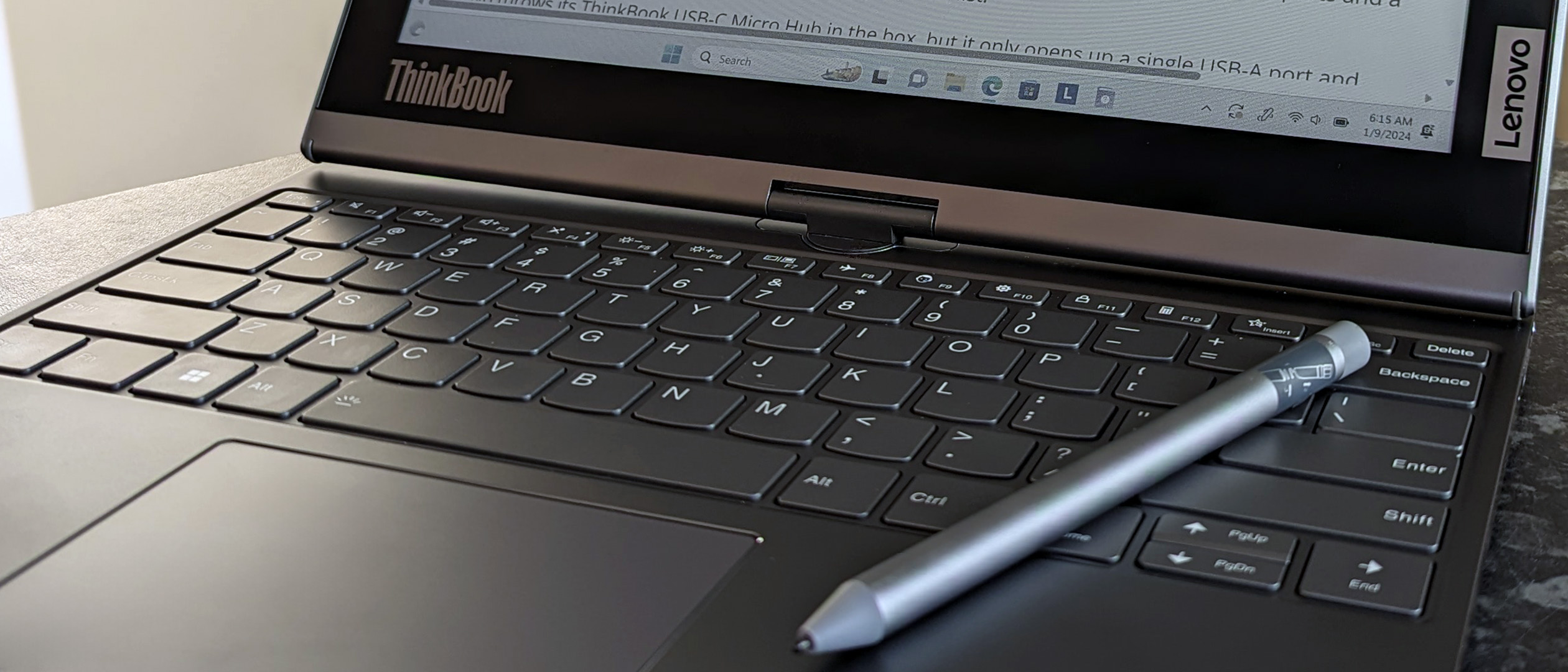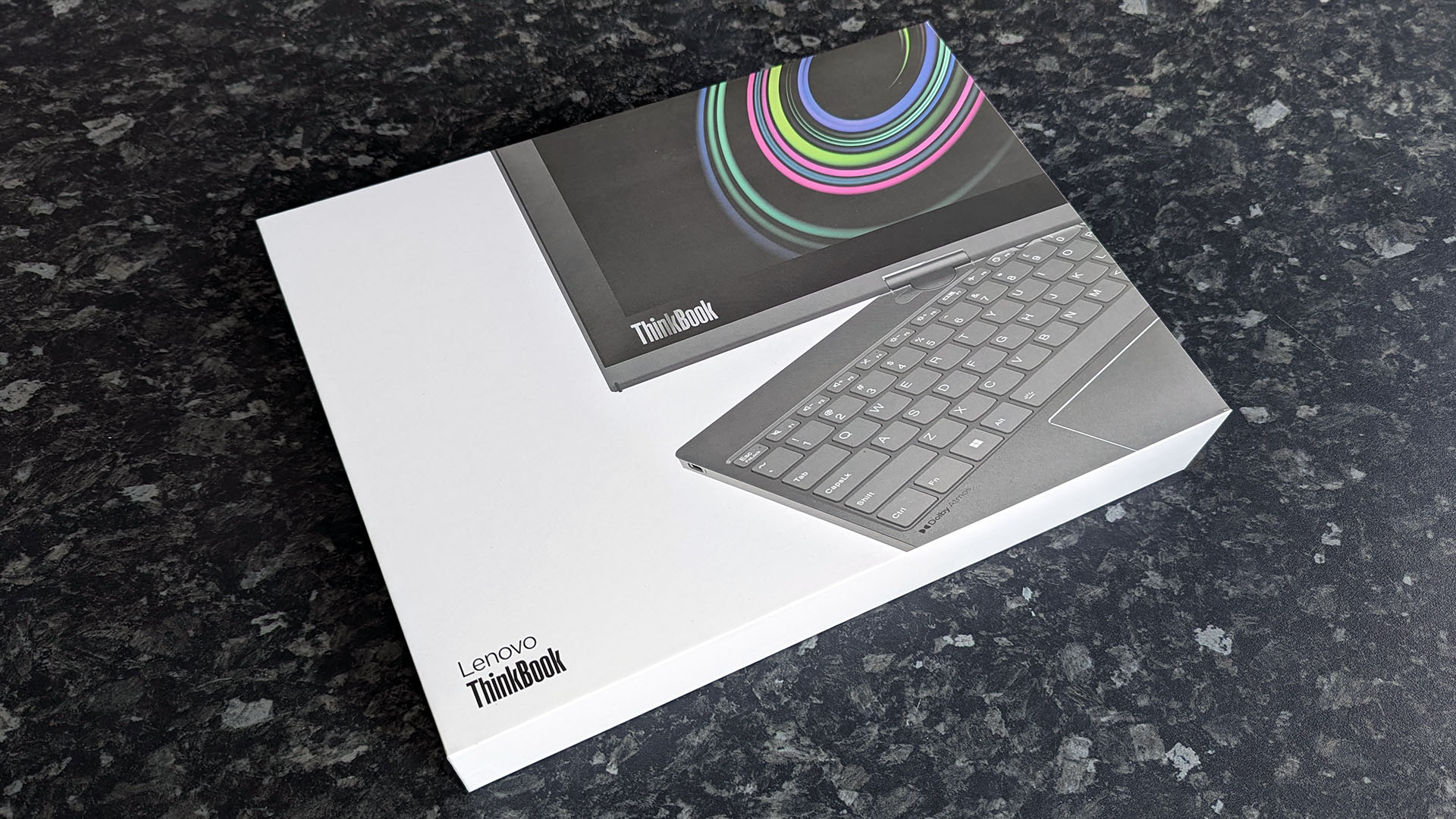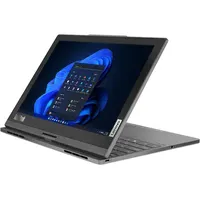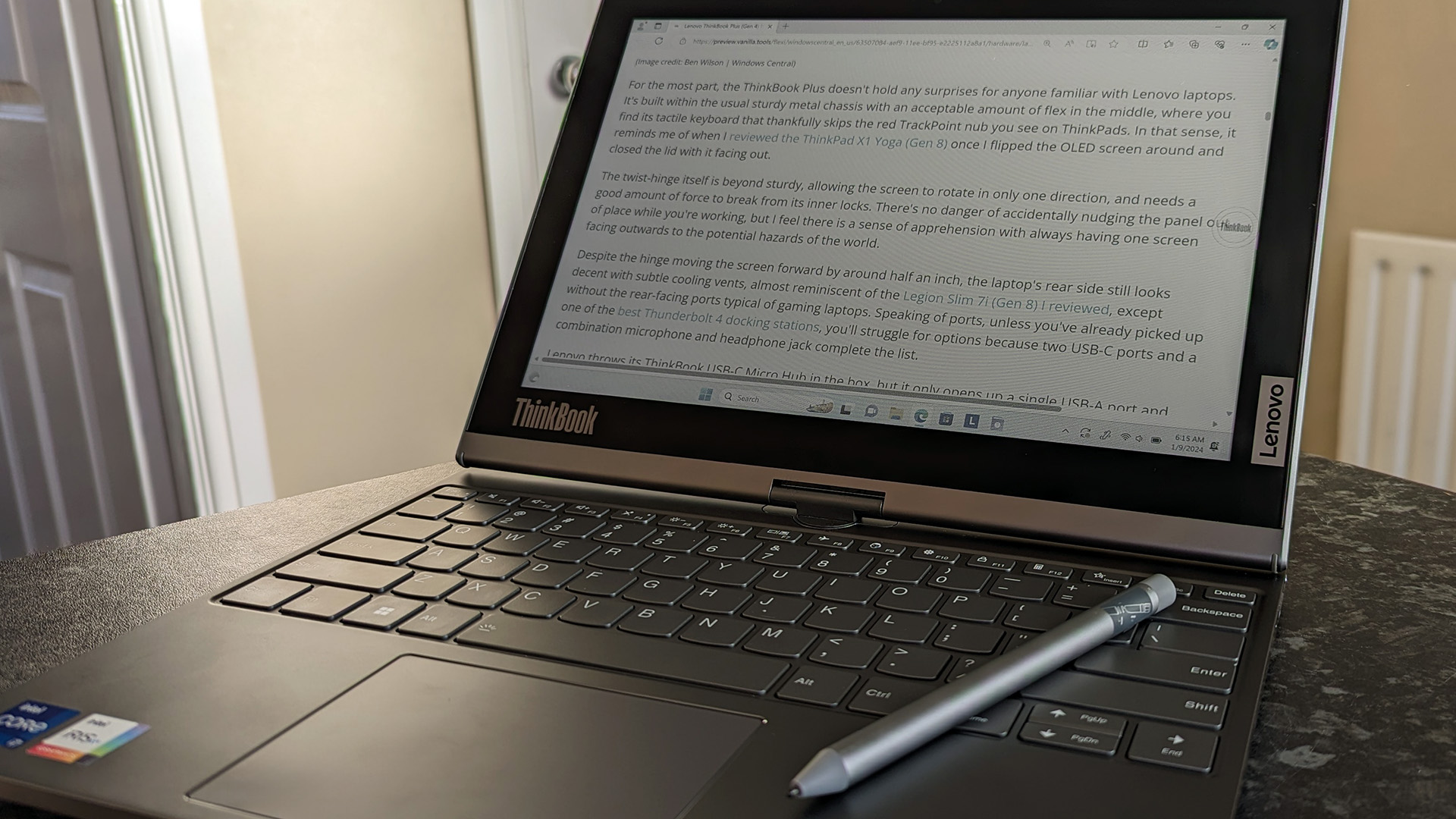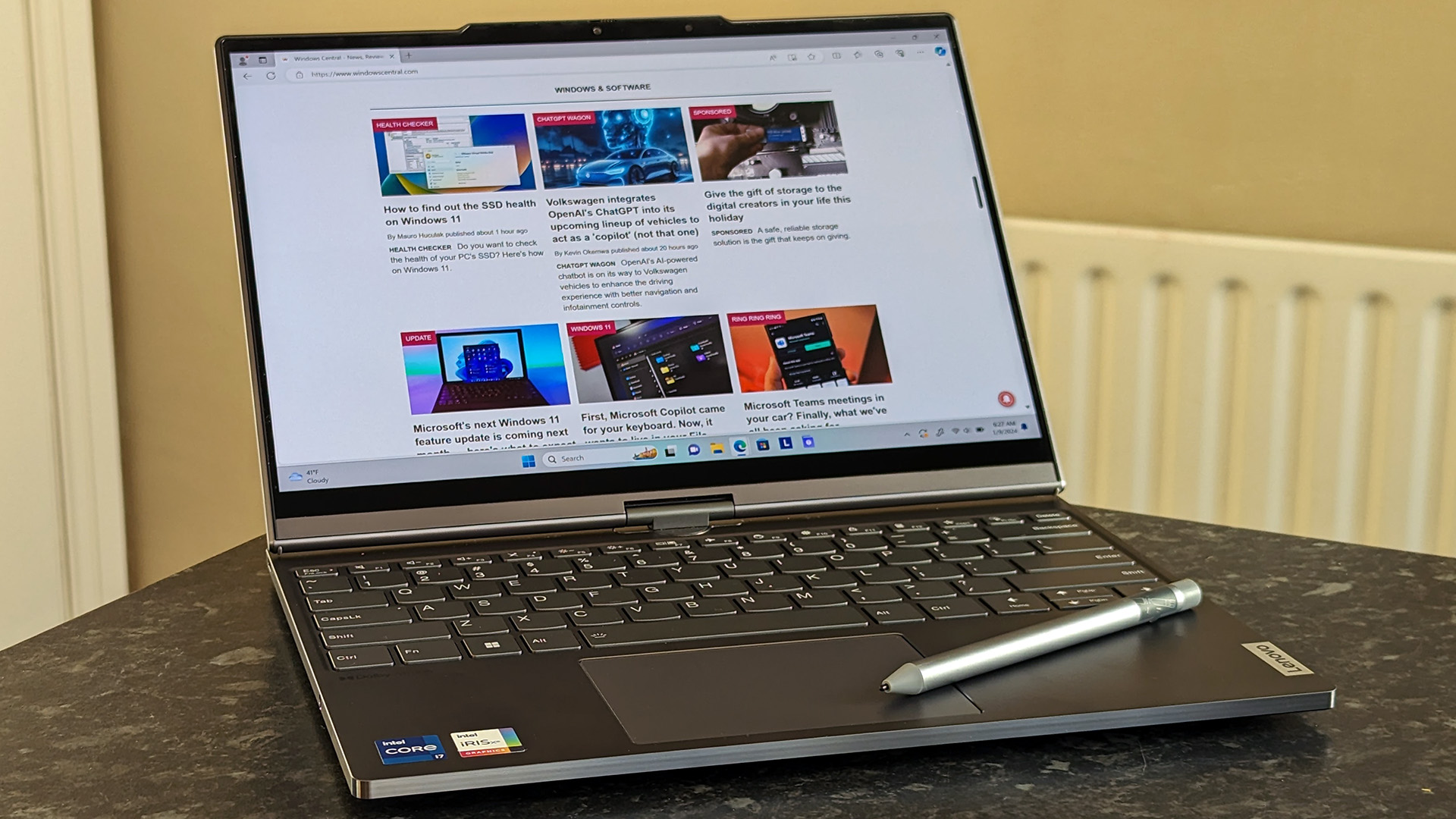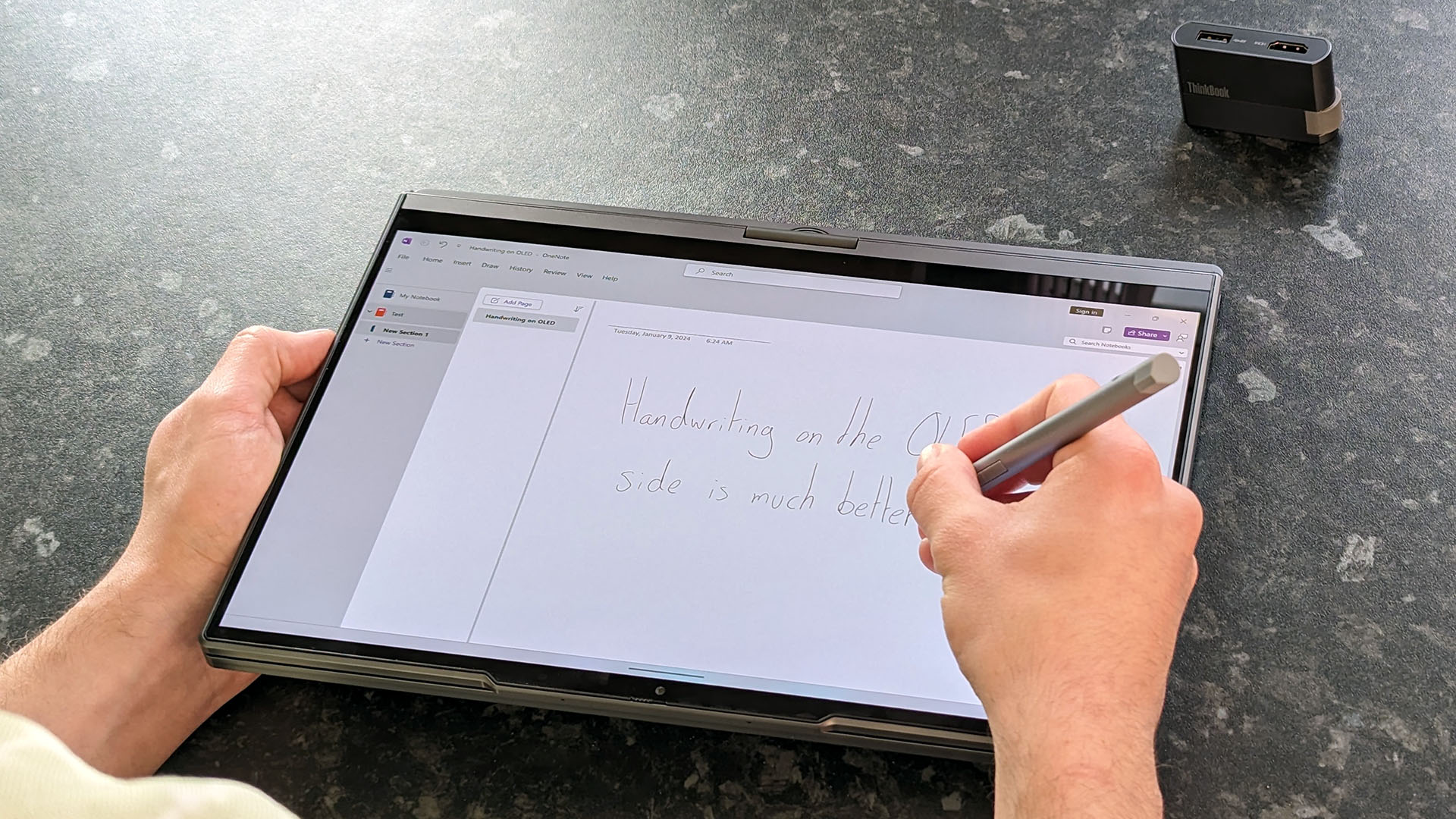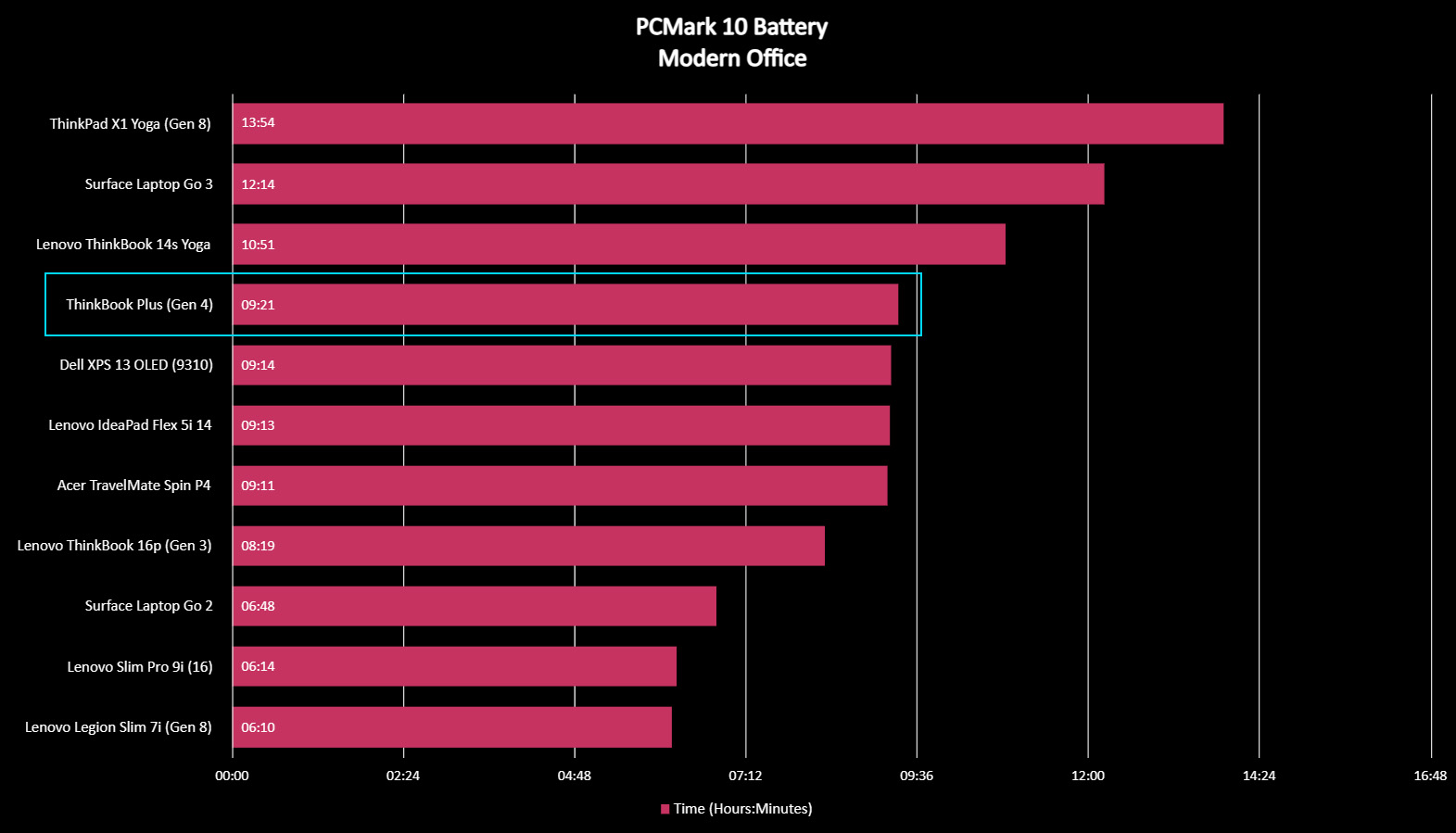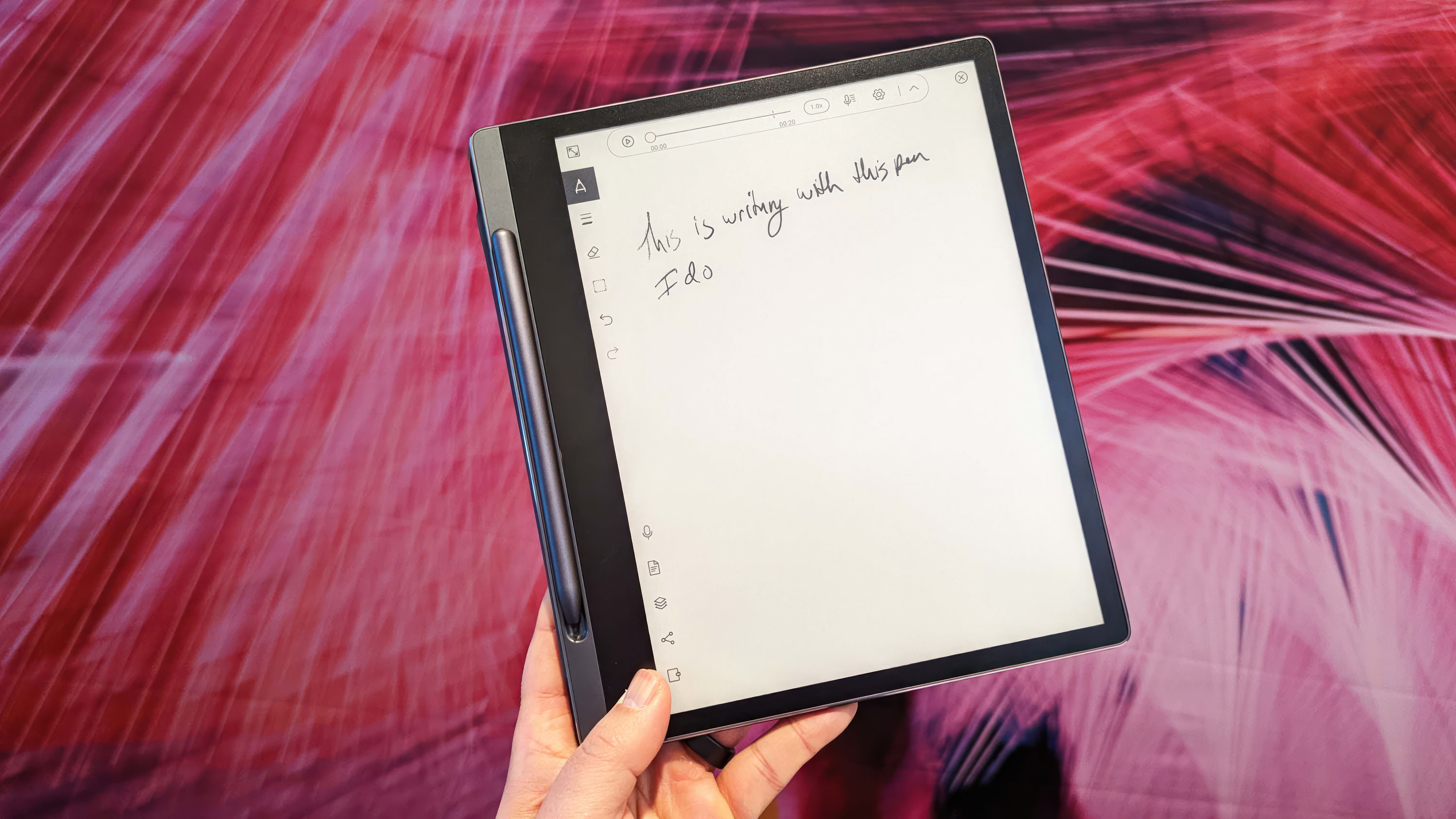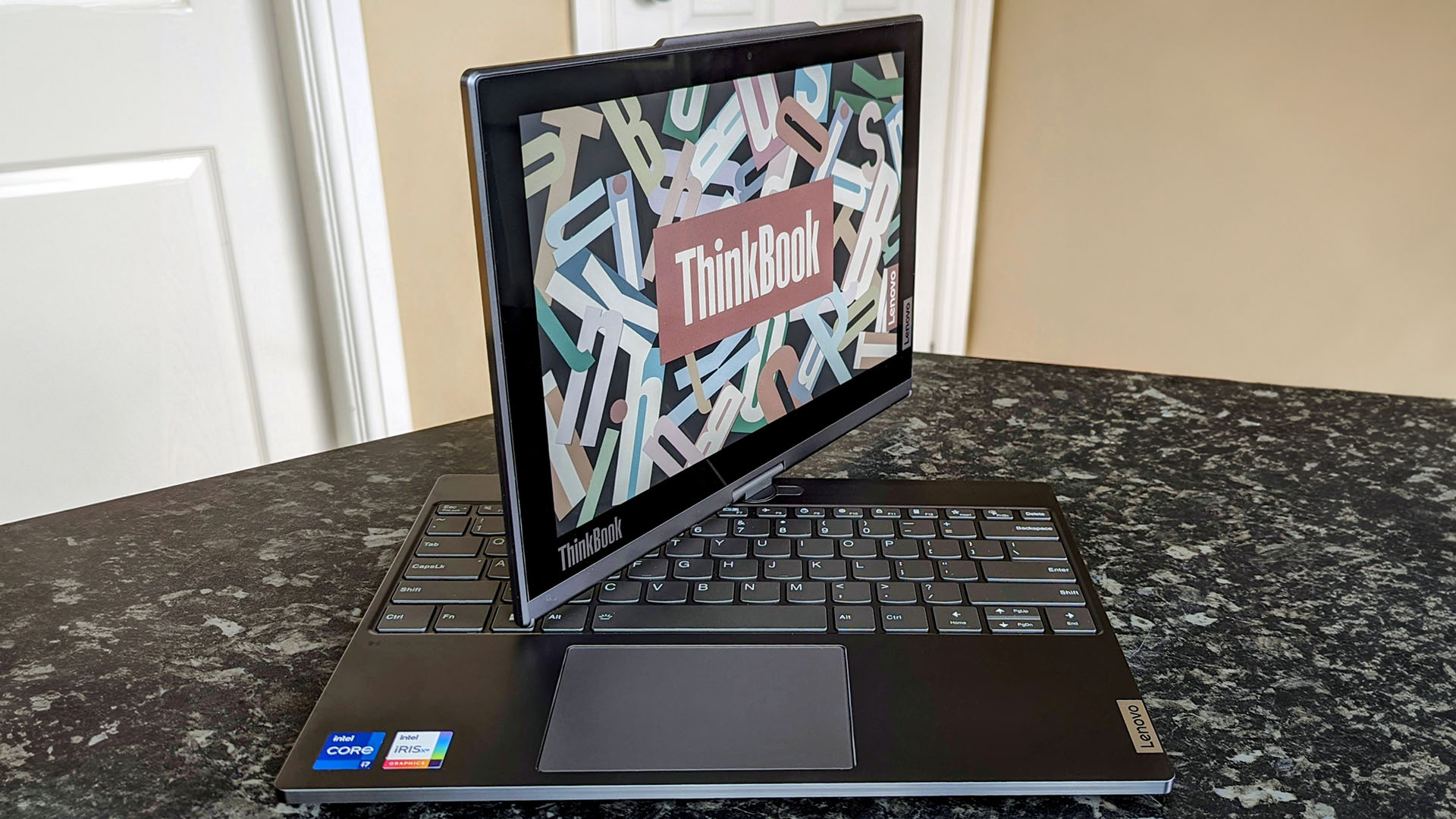Windows Central Verdict
The ThinkBook Plus Gen 4 feels like an example of 'just because you can, doesn't mean you should' as this CES experiment fails to prove genuinely tempting versus the strong competition from Lenovo itself and rival manufacturers. Most of its internals are borrowed from better Lenovo laptops, but the twisting E Ink screen will only benefit an extremely niche corner of the market, and even then, potential consumers will have to contend with its outrageous price tag.
Pros
- +
An innovative, if functionally niche, rotating hinge makes it a truly transforming laptop.
- +
2.8K OLED touchscreen offers excellent color accuracy.
- +
Sturdy metal chassis and a quality keyboard as usual.
Cons
- -
E Ink display suffers from severe ghosting issues and limited usability.
- -
Priced over $3,000 with regular availability issues.
- -
Restricted connectivity with only two USB-C ports.
- -
Single configuration for purchase with no customization.
Why you can trust Windows Central
Initially revealed as the ThinkBook Plus Twist during CES 2023, this quirky transforming laptop has been renamed ThinkBook Plus (Gen 4) for its release. However, the focus is still entirely on the rotating screen that reveals an E Ink panel on the back.
It fits perfectly into this Plus range, though the E Ink display skipped a generation and hasn't been seen in a similar rear-mounted fashion since the ThinkBook Plus (Gen 2).
Other standouts include a 60Hz 2.8K OLED touch screen on the front, mounted onto a chassis that's practically identical to most of Lenovo's business-focused laptops, but the 'twist' is undoubtedly the E Ink panel and Lenovo Base Pen 4.0 stylus.
So, is it anything more than a glorified note-taking tablet, or can it genuinely offer flexible usability to on-the-go professionals who double up on editing media and writing or reading long-form content as the best 2-in-1 laptop? I'll determine exactly that in my Lenovo ThinkBook Plus (Gen 4) review.
Disclaimer: This review was made possible by a review unit provided by Lenovo. The company did not see the contents of the review before publishing.
ThinkBook Plus: Pricing, specs, and availability
Price: $3,039 at Lenovo
CPU: Intel 13th Gen i7-1355U
GPU: Intel Iris Xe Graphics
RAM: 16 GB LPDDR5X-6400MT/s
Storage: 512GB M.2 2280 PCIe 4.0
Networking: Wi-Fi 6E 802.11AX
Display 1: 60Hz 2.8K OLED touch
Display 2: 12Hz E Ink touch
Stylus: Lenovo Base Pen 4.0
Size: 17.7mm x 297mm x 219mm
Weight: 1.35kg / 2.98lbs
Battery: 9hrs 21mins (benchmarked)
The Lenovo ThinkBook Plus (Gen 4) was initially launched at the official Lenovo store for $3,039 but suffers from particularly poor availability with a message regularly adorning the entire category:
"We're sorry, ThinkBook Plus Series Laptops Products are temporarily unavailable."
All the latest news, reviews, and guides for Windows and Xbox diehards.
There aren't any listings on third-party retailers since Walmart removed its store page, so the ThinkBook Plus is often unavailable in the United States. A similar note on the UK version of Lenovo's official store only reads 'coming soon' with no further information.
Whether this is a supply issue or a technical problem with components commonly used inside the ThinkBook range of Lenovo laptops isn't clear. Nevertheless, at the time of writing, the ThinkBook Plus (Gen 4) is regularly impossible to buy. At the start of January 2024, more stock was briefly added, but the trend soon returned with the listing switching back to 'available soon.'
There is only one configuration for this ThinkBook Plus, precisely the model I tested for review with a 13th Gen Intel Core i7-1355U mobile processor and integrated Intel Iris Xe graphics. With no customizable specifications available, 16GB of RAM and a 512GB solid-state hard drive is presumably all Lenovo had planned for the Gen 4 refresh.
Besides a 65W USB-C power adapter for charging, Lenovo includes its Base Pen 4.0 stylus and a ThinkBook USB-C Micro Hub in Storm Grey to match the laptop. Since only two USB-C Thunderbolt 4 ports are available, with one used for charging, the hub offers a full-size USB-A port and HDMI-out for external monitor support.
i7-1355U| 16GB RAM | 512GB SSD | Intel Iris Xe
Only one configuration available for the ThinkBook Plus (Gen 4) was available when writing this review, which means no customizable options for expanding storage space or adding extra RAM.
ThinkBook Plus: Design and build quality
For the most part, the ThinkBook Plus doesn't hold any surprises for anyone familiar with Lenovo laptops. It's built within the usual sturdy metal chassis with an acceptable amount of flex in the middle, where you find its tactile keyboard that thankfully skips the red TrackPoint nub you see on ThinkPads. In that sense, it reminds me of when I reviewed the ThinkPad X1 Yoga (Gen 8) once I flipped the OLED screen around and closed the lid with it facing out.
The twist-hinge itself is beyond sturdy, allowing the screen to rotate in only one direction, and needs a good amount of force to break from its inner locks. There's no danger of accidentally nudging the panel out of place while you're working, but I feel there is a sense of apprehension with always having one screen facing outwards to the potential hazards of the world.
Despite the hinge moving the screen forward by around half an inch, the laptop's rear side still looks decent with subtle cooling vents, almost reminiscent of the Legion Slim 7i (Gen 8) I reviewed, except without the rear-facing ports typical of gaming laptops. Speaking of ports, unless you've already picked up one of the best Thunderbolt 4 docking stations, you'll struggle for options because two USB-C ports and a combination microphone and headphone jack complete the list.
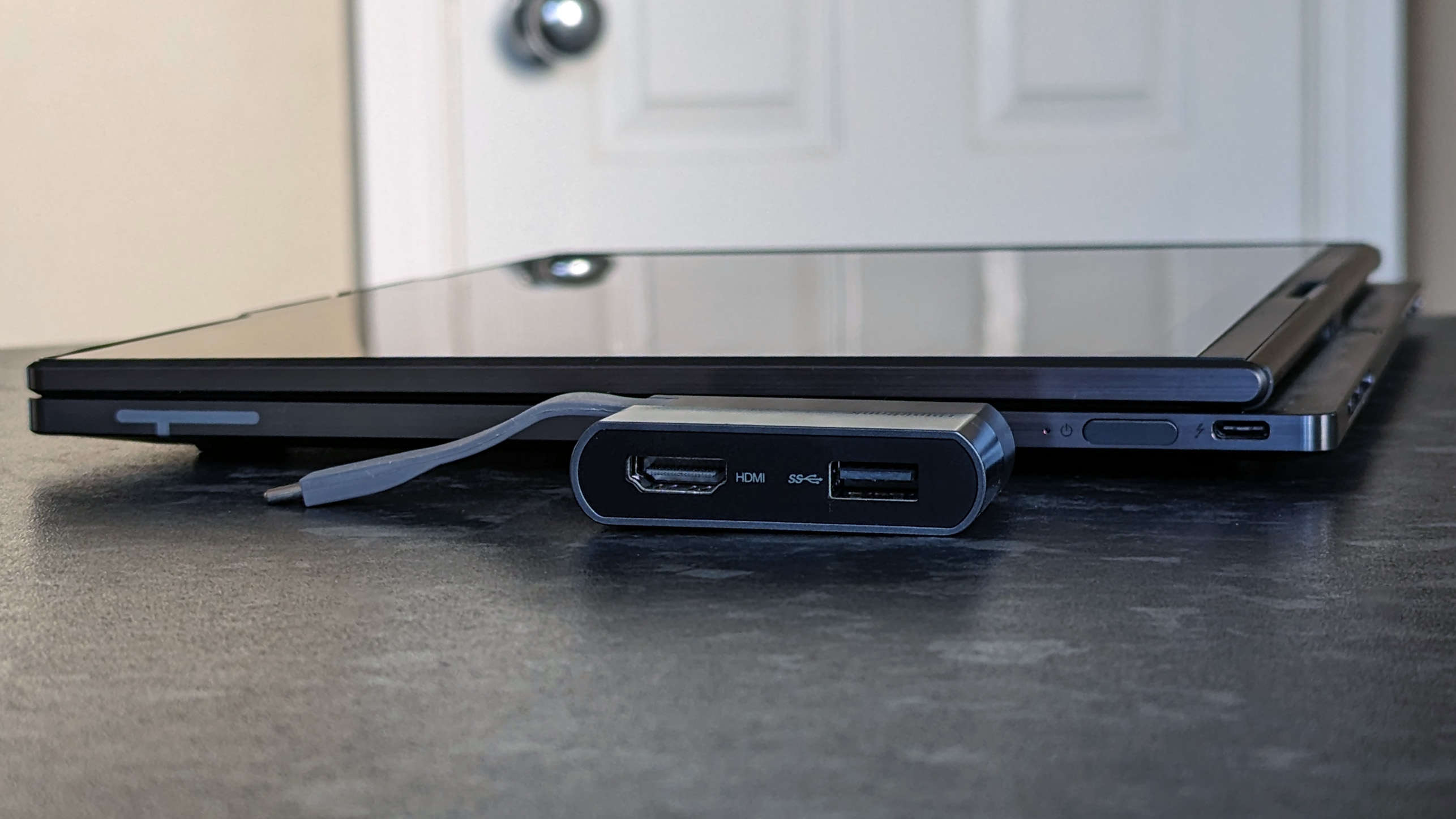
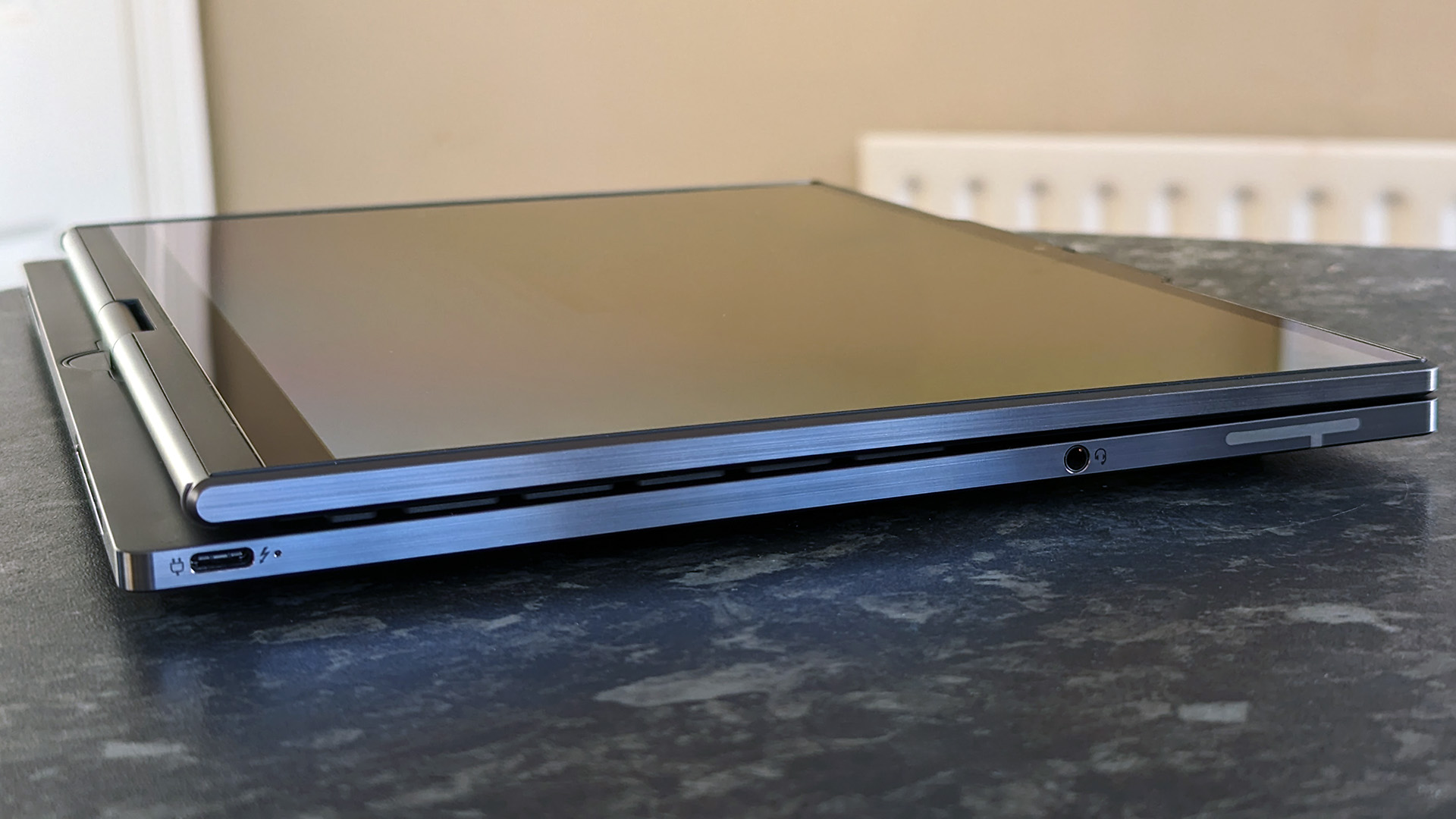
Lenovo throws its USB-C Micro Hub in the box, but it only opens up a single USB-A port and HDMI-out for external monitors, so it's a raw deal. If you're using this ThinkBook Plus with AC power connected, you're down to a single Thunderbolt 4 USB-C port, and opting for the Micro Hub to connect a single traditional USB-A device like a flash drive has you stumped.
I know USB-C is the new standard, but if I'm working on-site taking long-form notes, I'll likely need multiple peripherals and external storage drives, so it doesn't fill me with confidence that this Gen 4 revision would serve me too well on the spot. Nevertheless, the overall build quality matches the superb standard I expect from Lenovo, with the lid opening smoothly and its notch hiding a built-in webcam with a physical shutter.
ThinkBook Plus: OLED, E Ink, and stylus
The appeal of the ThinkBook Plus is its transforming, twisting screen: OLED on one side and color E Ink on the other. It's not the first Lenovo laptop I've seen with an OLED screen, so I had an idea of what to expect, and sure enough, it looks fantastic. It's a 60Hz touchscreen with a 2.8K (2880 x 1800) resolution that automatically disables HDR when on battery power. I opted to keep HDR off for my tests anyway, which all involved using the laptop in a portable fashion, leaning into its marketing as a high-grade notebook.
OLED: Vibrant and gorgeous as always
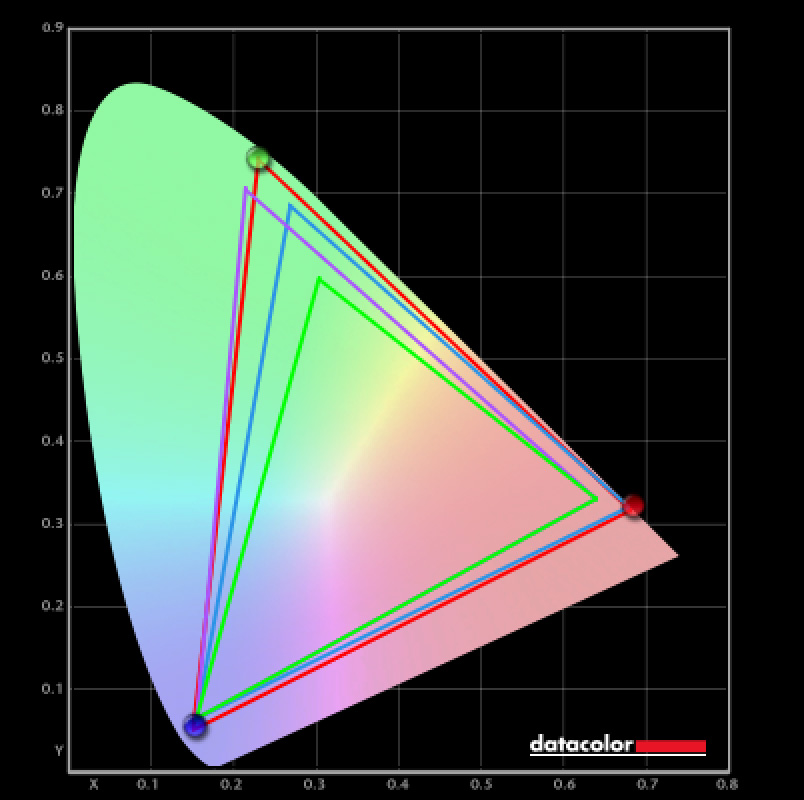
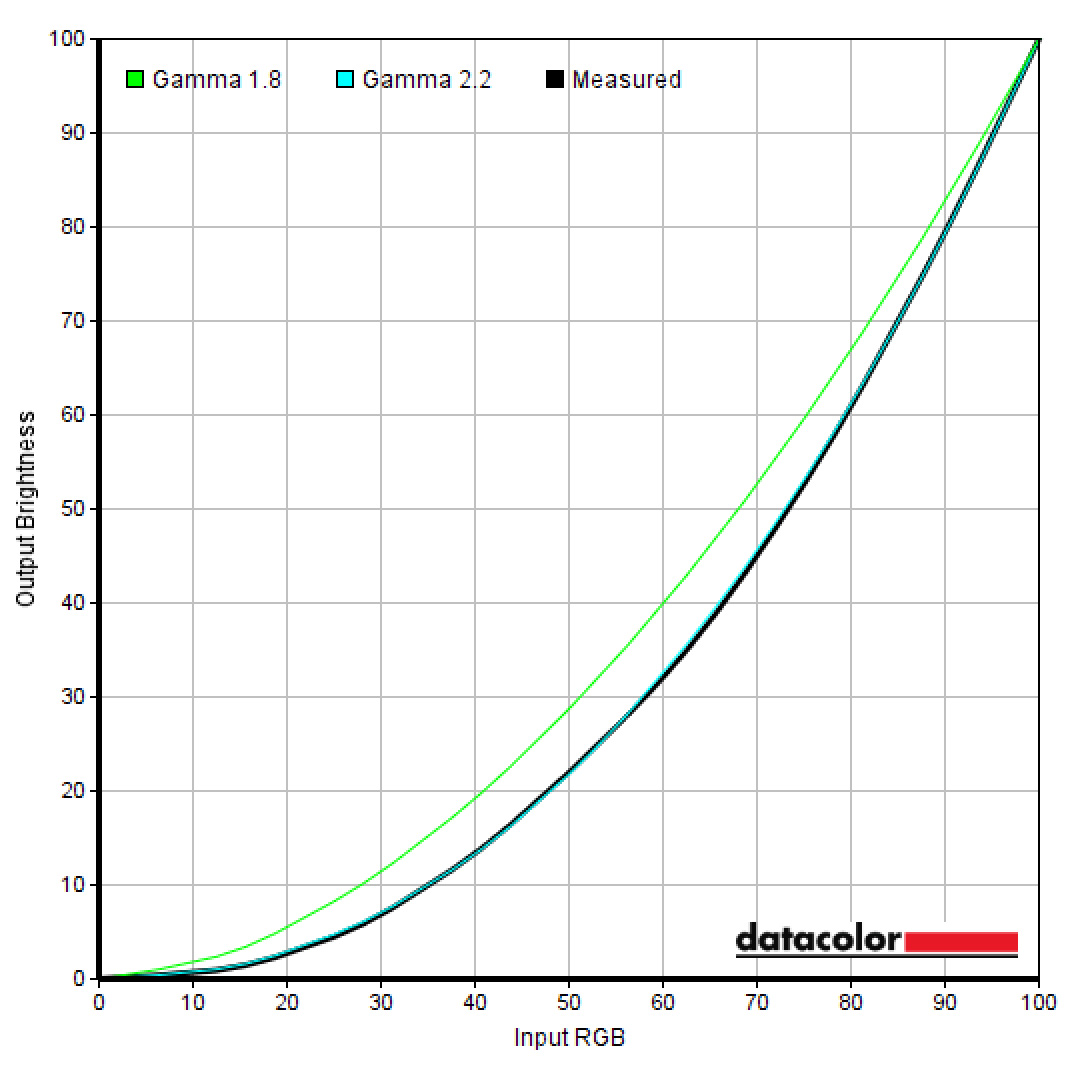


Testing the OLED panel with a SpyderX Pro colorimeter showed excellent color accuracy, covering 100% of the DCI-P3 gamut and 98% of Adobe RGB. In this sense, it lends itself to image and video editing on the go, perfect if you're snapping product photography or quickly editing B-roll footage for your brand. Keeping the refresh rate capped at 60Hz is a mild shame, as we've been spoiled by 120Hz OLED panels on laptops like the recently reviewed Acer Swift X 14.
Handwriting with the Lenovo Base Pen 4.0 also feels responsive on the OLED side, as does general navigation of Windows 11, thanks to a more intricate level of accuracy for careful taps. It's a delight to use, even if it feels a little expensive when the higher resolution comes with a 60Hz trade-off. Either way, I'll always feel more comfortable using a stylus on an OLED screen rather than getting my fingerprints on such a pristine, gorgeous panel, so the experience is pretty satisfying on this side.
E Ink: A miss for this twisty gimmick
For this section, I wrote all of the text on the E Ink screen and experienced all the quirks that come with the technology. Trying to determine whether it's better suited to strictly reading text or writing it soon resulted in neither. With each line break, the previous stays on the screen with about half transparency, triggering an intense ghosting effect that only increases as the paragraph grows. I wasn't expecting miracles from E Ink, but it was immediately unsettling to use.
On the right side of the screen, a circular 'ThinkBook' icon acts as a button to refresh the display and clear ghosted images, almost like shaking a 1960s Etch A Sketch or a throwback to degaussing an old CRT monitor. It works, sometimes needing four to five presses to clear out the old ghosted images altogether, but it's inconvenient. If I had brought this laptop to a convention like CES 2024 in Las Vegas, my patience would have already run out on this display, switching to the OLED side instead.
So what about exclusively reading content? If I enter Immersive Reader mode on Microsoft Edge to remove as much webpage styling as possible, leaving me with only black text on a white background, it's almost the same as reading books on an Amazon Kindle Paperwhite featuring the same tech. It's imperfect, and anything with deep outlines or the occasional colored advertisement image will trigger the same ghosting effect. At this point, if I'm holding the ThinkBook in tablet mode to read an article, I'm left wishing I was using a smaller, dedicated E Ink device instead.
Even using the Lenovo Base Pen 4.0 feels like a lesser experience on the E Ink side, with a brutal delay making handwriting feel awkward and difficult to maintain. At this point, it doesn't feel worth switching to the E Ink screen for anything more than signing your name at the bottom of a lengthy PDF contract that you're encouraged to read thoroughly. If you're in the business of text-focused documentation, it might have its appeal, but then the beautiful OLED screen can offer an entirely superior experience overall.
ThinkBook Plus: Performance and benchmarks
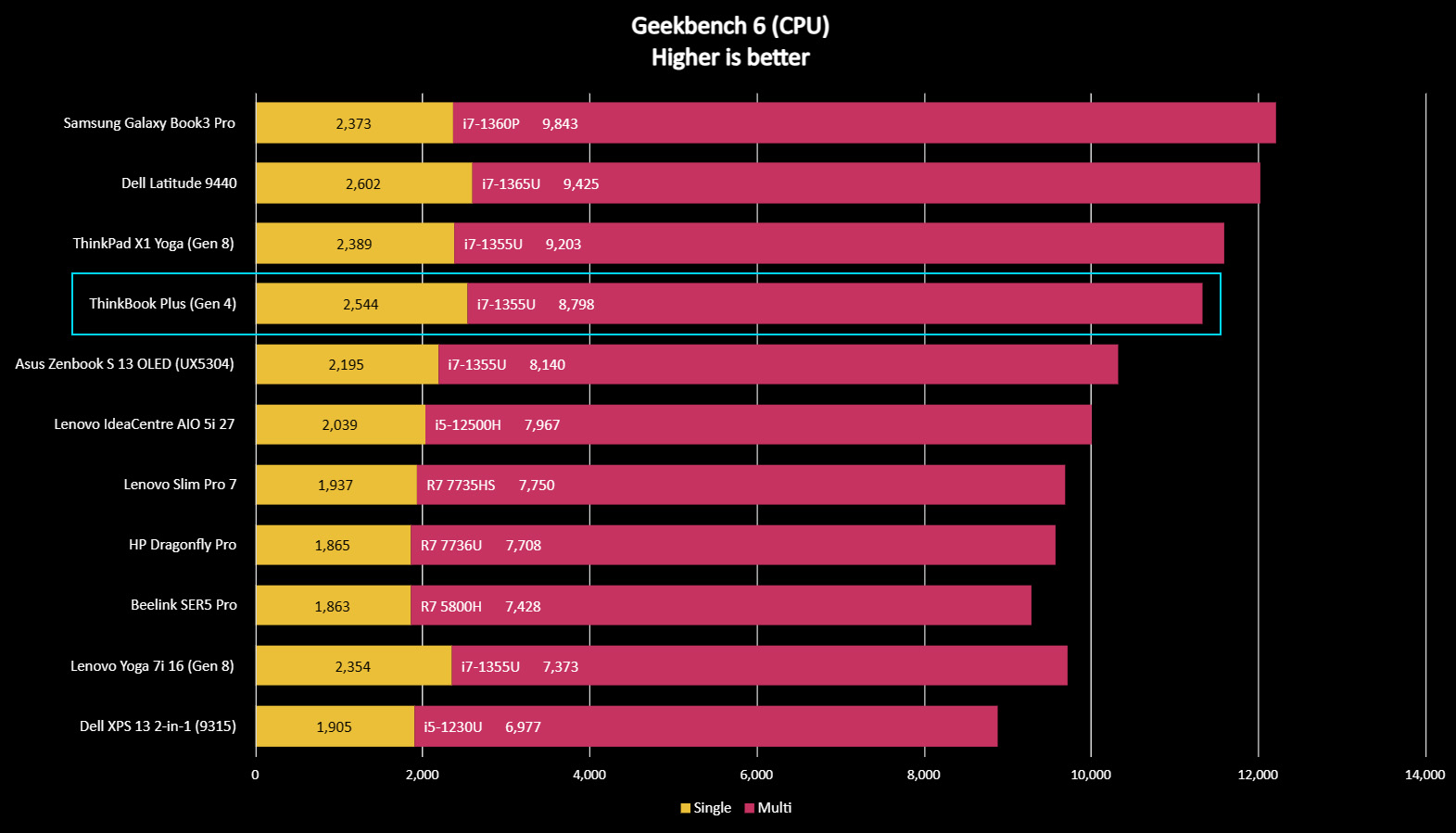
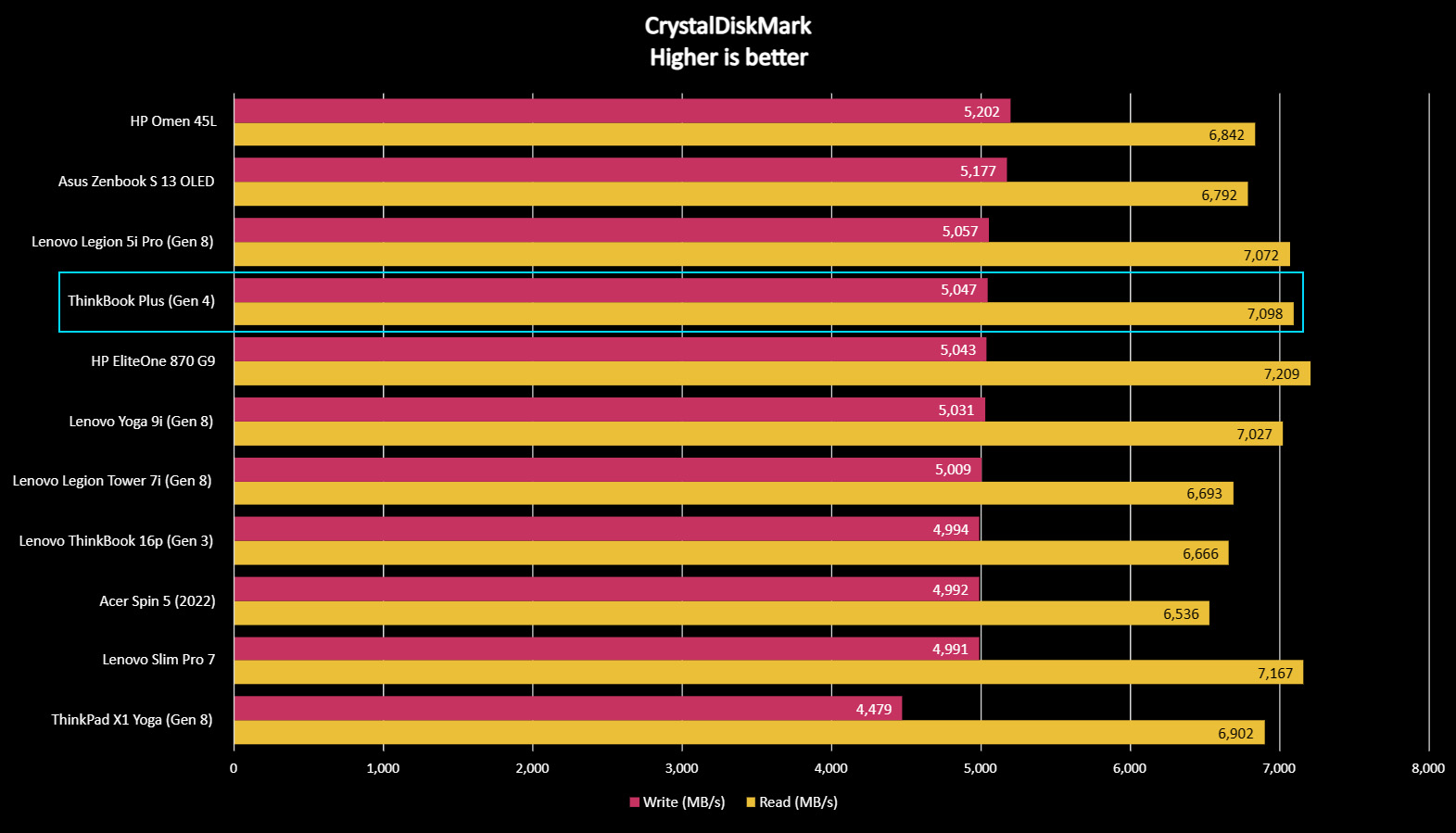
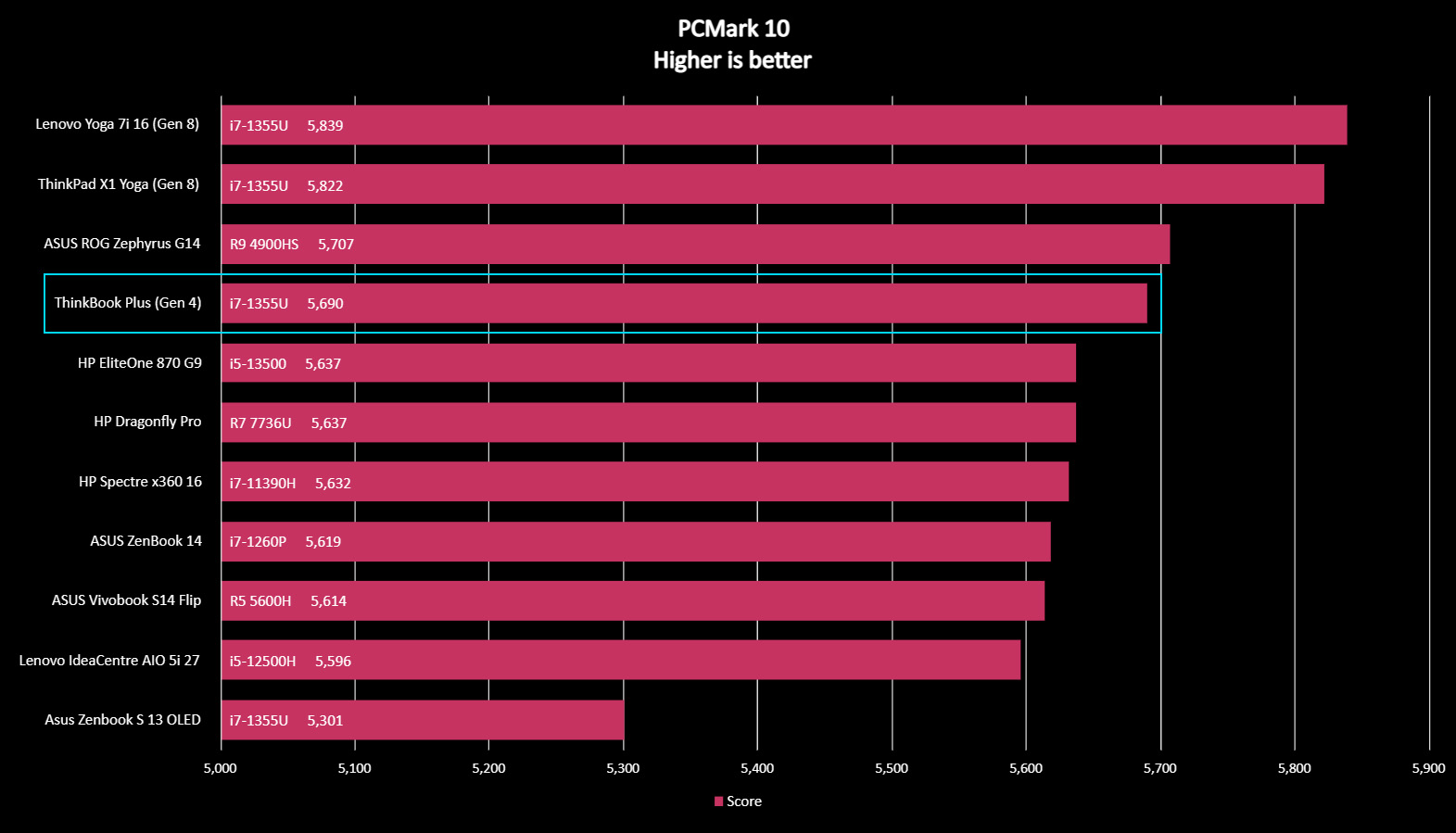


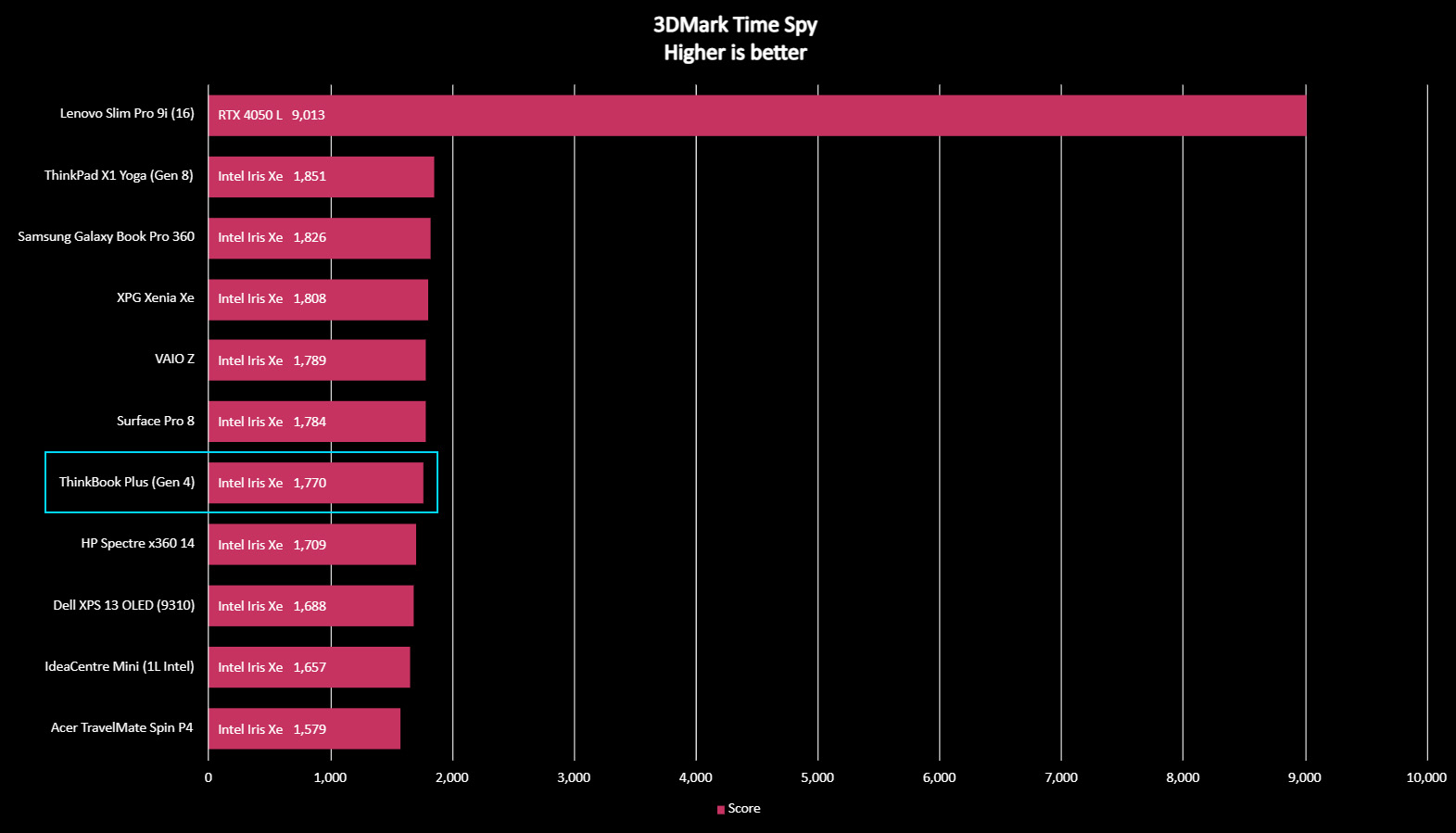
Regarding raw performance, the ThinkBook Plus doesn't do anything extravagant with its components and falls precisely in line where it should. The 13th Gen Intel Core i7-1355U processor is a 10-core, 12-thread chip that benchmarked almost identical results to the ThinkPad X1 Yoga (Gen 8) featuring the same CPU.
The 512GB SSD inside is an SK Hynix HFS512GEJ9X115N, a PCIe 4.0 M.2-2280 drive that crushes in read and write tests with CrystalDiskMark, writing at just over 5MB/s and reading just over 7MB/s. It helps with rapid boot times and fast installations, so there aren't any issues besides potentially running out of storage space.
PCMark 10 and CrossMark tests focusing on everyday productivity tasks score the ThinkBook Plus (Gen 4) close to the well-reviewed Surface Pro 9 and, again, the ThinkPad X1 Yoga (Gen 8.) A more intensive CPU-focused stress test in Cinebench R23 shows the i7-1355U struggles to keep up with the X1 Yoga by a decent margin, with repeated tests showing the same, potentially due to a slightly smaller venting pattern for cycling hot air.
This laptop holds its own in the areas it targets, performing well in office-focused tests alongside the respectable battery life result. Benchmarking the integrated Intel Iris Xe graphics seems almost pointless since the scores are always so close, and springing for a machine like my previously-reviewed Slim Pro 9i with an entry-level RTX 4050 dedicated laptop GPU would serve you much better if you rely on creative apps or play video games.
Battery life
Since the E Ink side uses as little power as possible, the battery is drained primarily by the actual components inside. This PCMark 10 test emulates common office-centric and productivity software alongside video calls, switching between apps and generally behaving like an average user might. A score of almost nine and a half hours is fantastic and in line with what I expected from a laptop featuring an OLED panel, even as its secondary screen.
It's not the best battery life I've ever seen, and I'll keep mentioning the excellent performance in my ThinkPad X1 Yoga (Gen 8) review for that reason. However, it's more than enough to survive a lengthy flight with actual use, and the E Ink screen does offer its benefits to stretch that out a little further if you're consuming content that suits the technology. Overall, it's more proof that Lenovo can truly offer all-day battery life when it targets its business-focused audience. It's just a shame that this 9-hour+ performance comes with such a hefty price tag.
ThinkBook Plus: The competition
To a frustrating degree, my top recommendations for competitors to the ThinkBook Plus come from Lenovo itself. While the ThinkBook Plus contains mostly top-grade hardware, the color E Ink screen doesn't perform well enough to justify the gimmick of a rotating screen and ends up being a less practical choice than other laptops in its range. It's typical of the brand to do something a little off-the-wall without sacrificing too much usability, but the price bump is hard to swallow when the main attraction is supposed to be the low-power E Ink tech.
If you want a business-focused laptop focused on battery efficiency and notetaking, get the almost perfectly scored Lenovo ThinkPad X1 Yoga (Gen 8) and pay an extra $200~ for an OLED panel upgrade with a customized order at its official store. On the other hand, if the OLED screen is your primary temptation, the Lenovo Slim Pro 9i is similarly close to perfection with more focus on creators thanks to its 100% DCI-P3 color gamut accuracy.
Finally, a smarter alternative for taking E Ink notes, albeit in black and white rather than color, is available via Amazon's Amazon's Kindle Scribe and Lenovo's Smart Paper. The latter includes a pen and a cover and supports audio recording, making it a stronger option for traditional notetaking that could be carried alongside a standard OLED laptop. The ThinkBook Plus just suffers from an identity crisis, failing to trump its separate elements better than siblings under the same brand, so practically any choice from its competition is a smarter option.
ThinkBook Plus: Score card
| Attribute | Notes | Rating |
|---|---|---|
| Value | It's simply too expensive when cheaper alternatives provide a better experience for both. | ★★☆☆☆ |
| Design | Lenovo laptops, once you peel off the stickers, are straightforward and clean. The twisting hinge is at least well implemented, if somewhat bizarre. | ★★★★☆ |
| Display | The OLED side shines, if somewhat limited by its 60Hz refresh rate. However, even added color doesn't make this E Ink panel worth the effort of manually clearing ghost trails from moving text. | ★★☆☆☆ |
| Performance | Intel's 13th Gen Core i7-1355U wins again, and the remaining components match those of similar Lenovo laptops. Hard drive is a little limited for space, considering the price. | ★★★★☆ |
| Battery life | Pushing over 9 hours is decent, though it is beaten by other laptops in Lenovo's X1 range at similar prices. | ★★★★☆ |
ThinkBook Plus: Should you buy it?
You should buy this if …
✅ You have a genuine need for both screens
If you're a traveling worker whose work involves reading or writing lengthy documents that require signatures mixed with high-grade photo and video editing, the ThinkBook Plus is an excellent travel companion if you have the budget to match.
✅ You want a high-quality OLED laptop
Lenovo knows how to build a rugged laptop, and despite the outward-facing E Ink screen, a simple pouch would be plenty to protect it during travels. Its solid construction and powerful components have real value as a creator-focused machine.
You should not buy this if …
❌ You want a long-lasting device for note taking
Too many better alternatives exist, including from Lenovo itself, to warrant the markup on such a niche device. Buy a separate E Ink reader like the Lenovo Smart Paper and an OLED Yogabook instead.
The ThinkBook Plus is an unusual device that fails to dominate both categories it offers simultaneously. Fortunately, the OLED panel combines reliable components and a solid chassis, forming a well-designed laptop with accurate colors and a respectable battery life. However, the E Ink gimmick on the opposite side of the twisting hinge fails to appeal to reading or writing plain text, given its reliance on refreshing the screen once a minute at the least.
It has more going for it than against it, so it's not necessarily a bad laptop. It simply struggles to have an identity compared to dedicated devices that can provide a better experience on both sides. It's hard to justify a purchase when it's a touch over $3,000 unless you will explicitly benefit from its niche, and I'd wager the perfect consumer for the ThinkBook Plus Gen 4 is somewhat of a rarity. It's an oddity but fairly typical of what Lenovo brings to CES.

Ben is a Senior Editor at Windows Central, covering everything related to technology hardware and software. He regularly goes hands-on with the latest Windows laptops, components inside custom gaming desktops, and any accessory compatible with PC and Xbox. His lifelong obsession with dismantling gadgets to see how they work led him to pursue a career in tech-centric journalism after a decade of experience in electronics retail and tech support.
